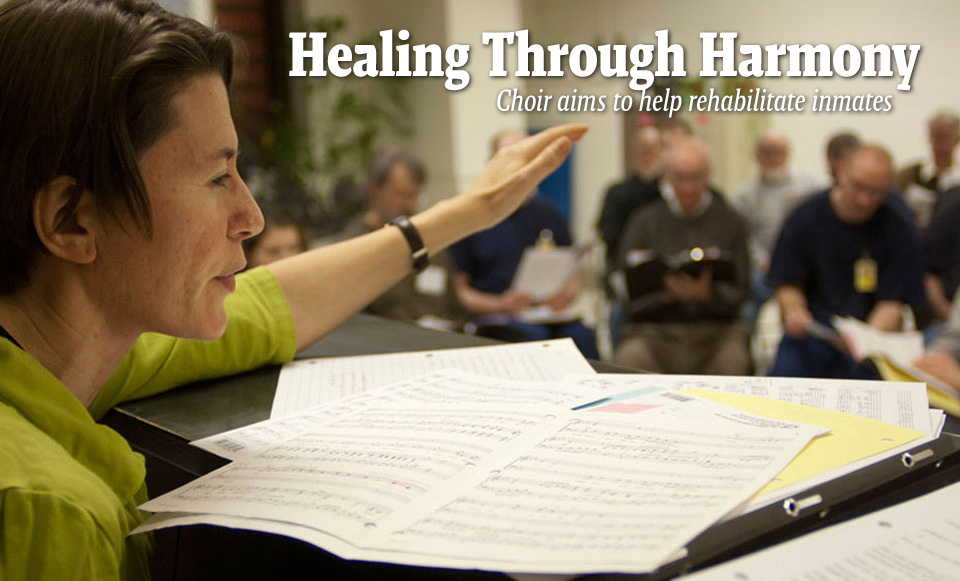-
Page Navigation Links:
- Skip to Site Navigation Links
- Skip to Features

- The University of Iowa
- Spectator
- Monthly News for UI Alumni and Friends
Six nights a week, inmates at the Iowa Medical and Classification Center (IMCC) in Coralville, Iowa, hear the same, monotonous sounds echoing through the correctional facility’s halls. For 90 minutes every Tuesday, however, there is a break in the repetitious dings.
This is when community volunteers visit a group of prisoners for a choir rehearsal, allowing the inmates to escape into a world of choral harmony. Together, the two disparate sets unite as one musical team, the Oakdale Prison Community Choir.
The vocal group was created in February 2009 by Mary Cohen, UI assistant professor of music education, as a means to help the incarcerated population communicate with others through song; the project also is coordinated with graduate seminars in music education. Approximately 30 volunteers, including University students and faculty as well as local residents, participate with about 30 inmates. The result is a melodious blend of stability, support, and strength.
“Prison is extremely repetitive, possessing a lot of dehumanizing aspects,” says Cohen, who holds a joint appointment in the UI Colleges of Education and Liberal Arts and Sciences. “This program gives them a chance to express themselves. Working together in a chorus alongside society allows them to convey those emotions through music—a human activity.”
Finding a connection
The beginning of each rehearsal is marked with anxious anticipation. Choir members enter the room with wide smiles and bright eyes. They are seated by vocal part, and the only thing that distinguishes the incarcerated from the volunteers are the inmates’ numerical nametags.
After briefly reacquainting, the singers begin with a familiar piece, “Beauty Before Me,” and then spend the remainder of the session practicing pieces for the group’s next concert program. The choir always concludes with “May You Walk in Beauty.” Individuals exchange good-byes, and the long wait for the next rehearsal begins.
Daniel Craig, IMCC warden, says he approved the choir for its rehabilitative possibilities.
“Any time we are able to provide opportunities for offenders to interact with members of the community, filling idle time, it is positive,” says Craig. “Not only do the offenders learn an appreciation for the art of music, but they also learn social skills via positive role models as they relate through a common connection—music.”
Changing perceptions
Cohen says that before the choir’s first rehearsal, many volunteers expressed uneasiness about interacting with prisoners. Despite those early concerns, their intrepidness has created worthwhile results—and almost every volunteer’s initial perceptions of inmates have switched to positive.
Rose Schmidt, a UI senior and music education major from Williamsburg, Iowa, joined the choir in January 2010 after learning about the program through Cohen. Because her impression of inmates was rooted in media portrayals—prisoners in orange jumpsuits, shackled together and possessing an incredible potential for violence—Schmidt admits she had some reservations. But she says the experience has facilitated her growth as a singer and as a person.
“The first time I went in I was nervous because of the barbwire fence, the cameras constantly watching, and the huge, metal double doors,” says Schmidt. “Once we began singing, I realized these people are just like everyone else, except they made a mistake, and I thought, ‘Yes, they may have done something wrong, but they aren’t doing anything wrong to me.’”
Creating hope
Participating in the choir has been a positive experience for the inmates, too. Ron, an inmate and choir member who requested his last name be withheld, says the choir gives everyone a feeling of value and creates a wonderful environment.
“There is a fear we all have, ‘Will I be accepted when I get out?’” he says. “In the choir, people from the outside do accept us, and the cumulative effect of everyone’s efforts ends in great joy.”
Noting that 95 percent of all prisoners eventually will be released, Cohen says programs like the choir are pivotal because they help ease inmates’ transitions back into society.
“It is time for U.S. citizens to think about prisoners as people,” Cohen says, “and to consider more educational programs and activities behind bars that will heal the harm caused by criminal behavior, as the tenets of restorative justice suggest.”
—Travis Varner
photo by Tom Jorgensen
© The University of Iowa 2009
